Lure Fishing For Trout: Tactics Of A Pro River Guide
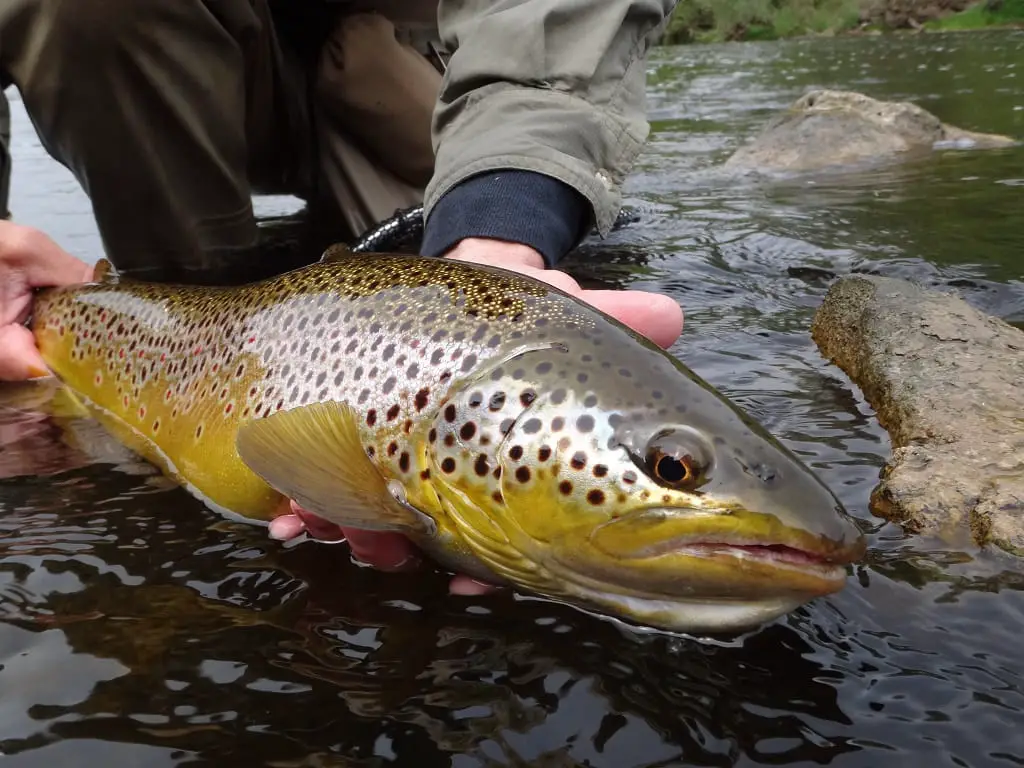
I run one of the top river guide services in my area for over 20 years, and one of the things that I do is teach anglers how to catch trout using lures.
Lure fishing for trout can be one of the most effective ways to catch trout in a river or a stream, but it’s also the most effective method on lakes and ponds. Trout fishing with lures is also easy to learn and doesn’t require much gear.
One thing I really like about using lures for trout is that lures really do a good job of attracting and catching large trout.
Use The Best Lures When Lure Fishing For Trout
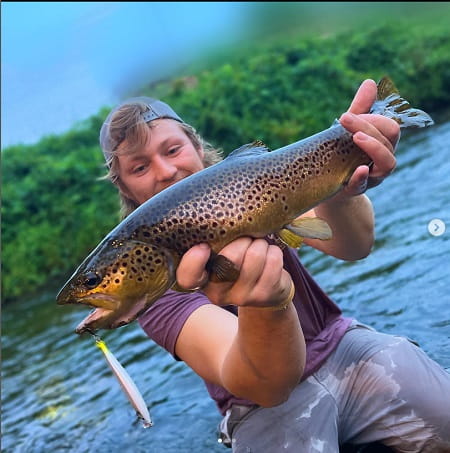
The best lures for trout are spinners, spoons, crankbaits, jigs, and plugs in a variety of sizes and colors.
If you are going to try fishing for trout with lures, you will want an assortment of lures, which include lures that go deep, lures that can be fished shallow, lures that can be fished fast, and lures that can be fished slow.
Good trout lures will have good action and vibration.
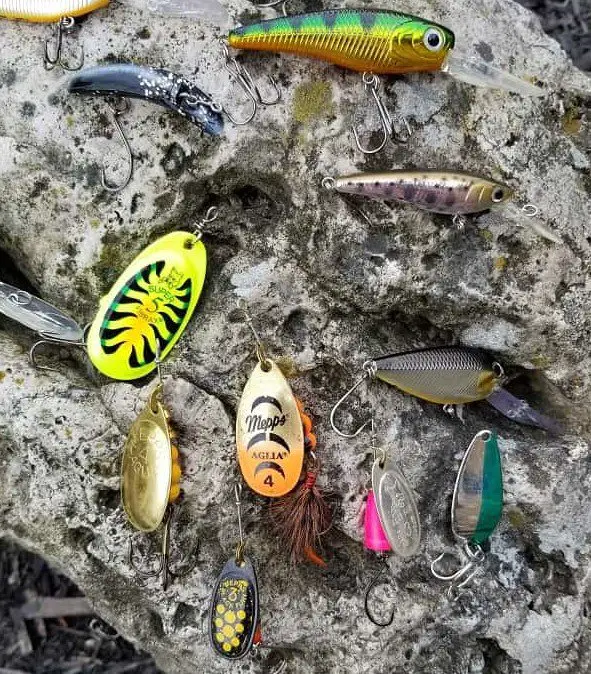
For more information on my favorite lures and lure brands, the best sizes, and the best colors for over 11 lures for trout, check out my page on the Best Lures For Trout.
Baits like worms, eggs, corn, grubs, or maggots are also effective but I don’t consider them as lures. Best Baits For Trout page.
Use The Right Size Lures For Trout
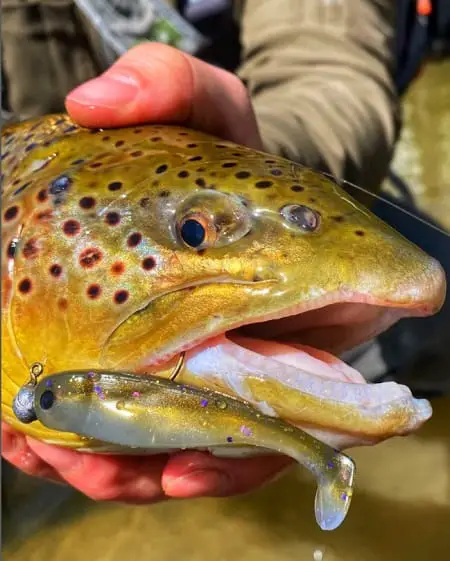
One of the first things to consider is the size of the lure. Even very large trout will hit a small lure at times, and small trout will hit a large lure sometimes.
I change my lure sizes based on several factors, and every day can be different. One day, you might catch lots of trout on a 3-inch spoon, while the next weekend, the trout won’t touch it.
These are the top things I consider when choosing the right lure size from most important to least important:
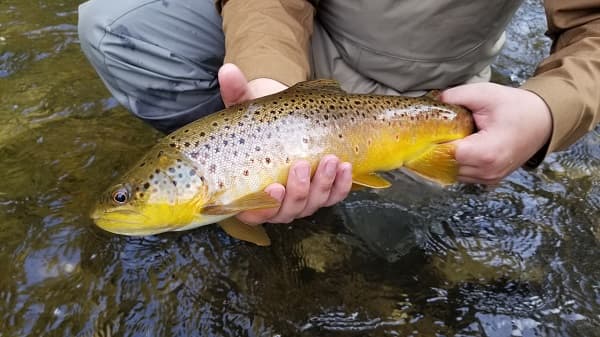
- The average size of the fish in the rivers.
- The fish’s activity level.
- The color of the water and the clarity.
- Size of the river that I am fishing.
- The water temperature
- Size of the forage or bait fish the trout normally feed on.
- The light conditions.
Trout Size Versus Lure Size
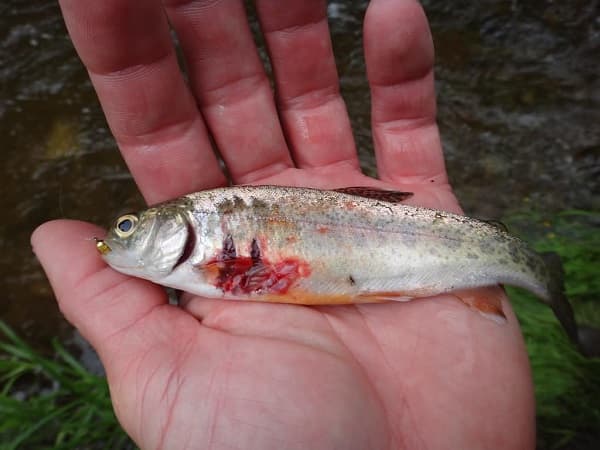
If I’m fishing a river that is mostly 5 to 10-inch brook trout, I would likely start with lures in the 1-inch size since these smaller trout have small mouths and since the bulk of the food these trout would eat would be smaller.
On a river that has both small and large trout over 20 inches, I may start with a 2-inch lure and then up-size to lures up to 6 inches long.
Most years some of the largest trout that my clients and I will see are huge trout that attack the smaller trout that my client is reeling in. I have seen 24-inch brown trout grab 8-inch trout.
Use The Right Size Of Lure For The Fish’s Mood
I will often start with a small lure, and if that doesn’t work, I will start trying larger lures. The reason I start with smaller lures is that it’s less likely to spook a nervous trout in very clear water. If they don’t eat the small lure I will keep going up in size.
There are times when I will start with a two-inch lure and get no results, which is when I will start upsizing to a larger lure, and when I get to a 6-inch lure, that’s when that one huge trout that only wants a big meal finally decides to grab it.
If I find that the fish are very aggressive I find larger lures can work well but if I find that the trout are not biting I often find downsizing to smaller lures is best. Basically, you will need to experiment to find the right size for the fish.
Using The Right Trout Lure For Water Clarity
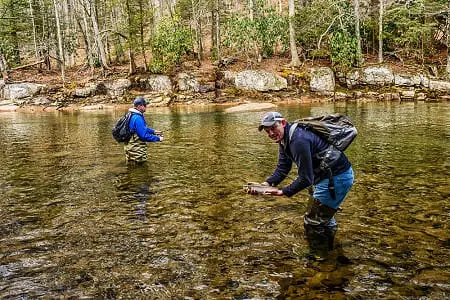
In very clear water, I will often use smaller lures, but if the water is dirtier, I will use a larger profile lure that the fish will see better.
GUIDE TIP: Use lures that make a lot of sounds, like a rattle or a vibration when fishing in dirty water. The sound will help the trout determine that the lure is there, and it will help the trout home-in on the lure and hit it. A spinner like the Vibrax brand will be a lot noisier than a spoon or a jig.
Use the Right Lure Size For The River
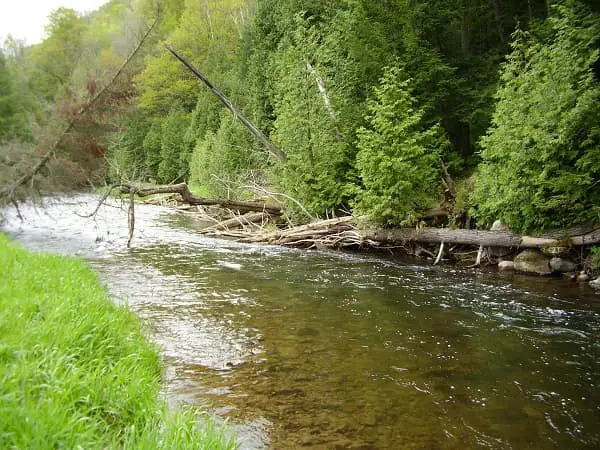
In small streams where I don’t need to cast very far, I will use lures that are much lighter and smaller. These lures won’t make a big splash in a small pool and spook the fish.
In larger rivers requiring much longer casts, I will go to a larger or heavier lure that can be cast a long way.
The Right Lure For Water Temperature
This comes back to the fish’s activity level. If the water is very cold or the water temperature has dropped fast, the fish could be very inactive and I find a smaller lure moved slowly will often entice the most bites from a trout. In the winter, a slower erratic lure will often entice the most strike.
Lures that wobble and move slowly, like the Kwikfish, Flatfish, or the MagLip, can be an excellent choice for cold water trout. You can see all of these on the Best Lures For Trout page.
Match The Lure To The Bait Fish
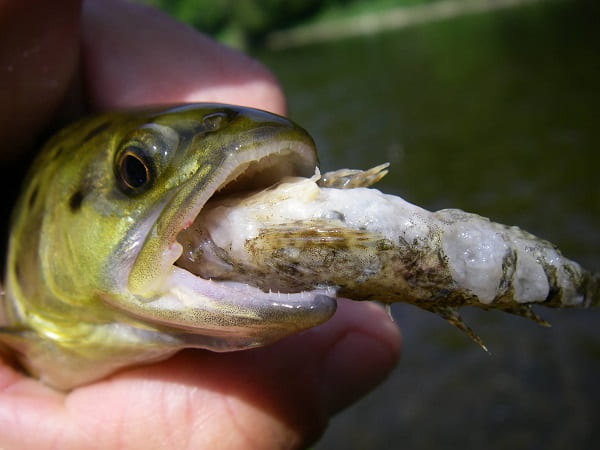
You would be surprised what trout will eat. I catch many 20-inch to 26-inch trout on flies less than a 1/4 inch long, and I have hooked very small trout on lures over 6 inches long.
The Right Lures For Low-Light Conditions
Under low light conditions and when fishing at night, I find that larger lures will work better than smaller lures. Lures that move slower and have some noise like a rattle or a vibration also tend to work better in low light conditions of early morning, dusk, and night.
I also find that trout are often more active in low light conditions, and as I said before, more active fish will hit larger lures.
Use The Right Lure Colors
Using the right lure colors is very important. Under certain conditions, the trout will be more aggressive on one color versus another color.
The best lure colors for trout are silver, gold, orange, olive, and black. However, under different light conditions and water clarity, other colors like Chartreuse, red, and pink can be good. Using colors that match the natural forage of the river is also a good idea.
Lure Fishing Small Streams
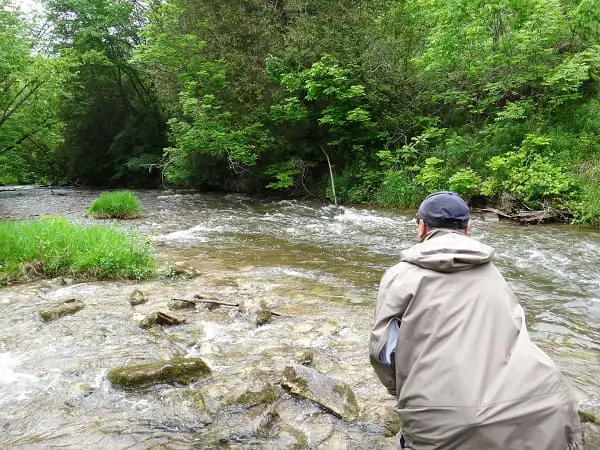
Lure fishing in smaller streams and rivers calls for different lures and different tactics than you would use in larger rivers.
Small stream fishing may mean one or two casts in a pool or pocket, and then you move.
Lure fishing in small rivers doesn’t require heavy lures that can be cast far, and large lures can sometimes spook trout in smaller clear pools. It’s best to start with small lures and then work your way to larger sizes.
The best lures to use in small rivers are spinners, spoons, and jigs, but I have done well with small plugs too.
When trout fishing with lures in a small river, you may need to change your lure based on the size of each spot. A spot that is 15 feet long and 10 feet wide can be fished with a plug that needs to be reeled in to give it some action, but a spot that is 3 feet wide and 3 feet long may not be big enough for a plug but might be perfect for a jig or a spinner.
Small rivers and small spots will require a different lure but also a different approach.
Lure Fishing Larger Rivers
If you are fishing larger rivers that are 30 feet across or more, you will need to change your tactics and your lures. Fishing larger rivers often requires bigger lures or heavier lures that can be cast far enough to get to the fish.
You will also need lures that can get deep enough since many larger rivers are deeper. Using a 5-inch Rapala crankbait that only dives 3 to 5 feet deep may not be the best option, which means you will need to find lures that can get to the desired depth.
You also need to know where the right depth is and how to get your lure there, which I discuss below.
How To Fish Lures For Trout Effectively
I watch many anglers fishing for trout with lures and they do so with very poor technique, and the results are that they miss a lot of trout.
If you are going to lure fish for trout, you need to know how to cover the water properly and that means with each cast and at every depth. You also need to know how to work your lure since different lures work differently.
To do both of these, you need to be in the right position and you need to know how to get the lure in the strike zone.
Cover The Water Effectively With Lures
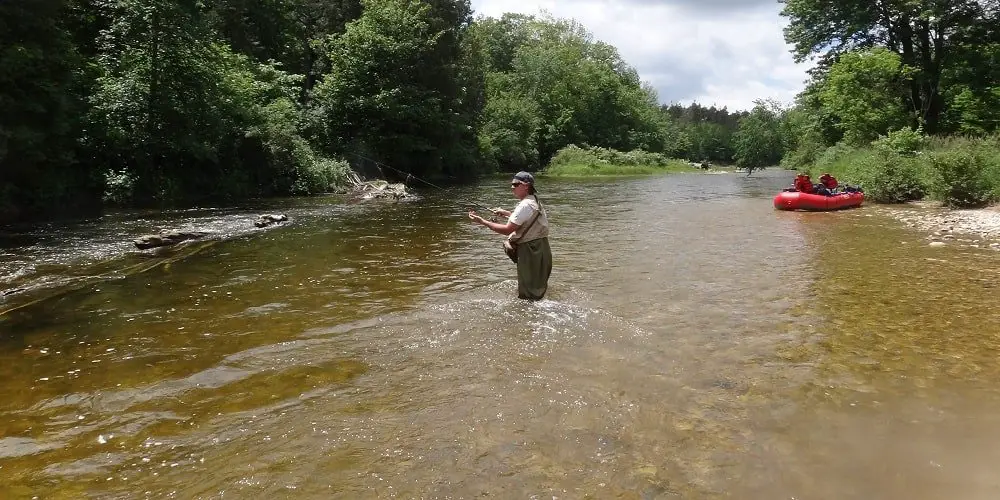
This is likely the biggest mistake the average angler trying to catch trout with lures makes. Most anglers do not systematically cover the water and will start throwing their lures aimlessly in all different directions. This is a big MISTAKE and is the reason why a lot of anglers will go home empty-handed or with few fish landed.
To cover the water with a lure effectively you need to have your starting point and your end point in mind and make sure you cover every 3 to 5 feet of the spot you will be fishing.
When fishing for trout with lures, you should almost always start casting at the top of the pool and then work your way down the pool, instead of starting at the bottom of the spot and working your way up.
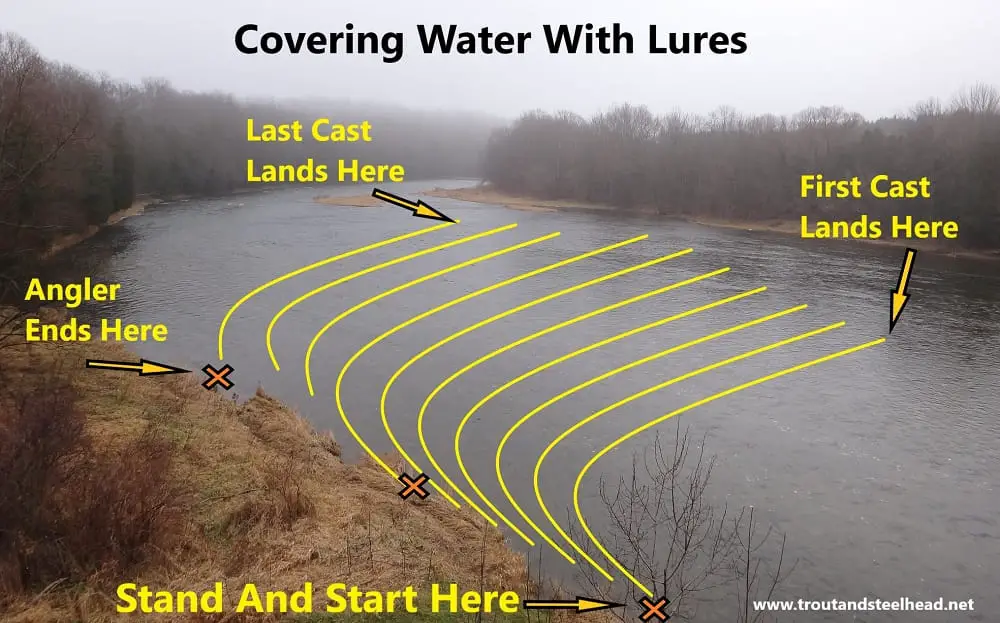
Part of the reason for this is that trout face upriver most of the time, and a lure being dragged up behind the fish might spook it. Because a lure that is behind the fish may not be seen, so the trout won’t eat it.
The exception to this rule is fishing in low, clear water with trout that are nervous. It may be better for you to stay behind the fish so they don’t see you and get spooked. A spooked fish’s first instinct is to freeze, and they will go lock-jaw, and that means they won’t eat anything.
The picture below shows a few things. First, the angler in the picture is way too close and should be back about 10 to 15 feet from where the blue lines start. Second, the blue indicates the direction of the cast and ends with a yellow dot where the lure should land. Each cast should be as far to the opposite side of the spot as possible.
The yellow line indicates where the water goes from shallow to deep, which is the edge of the pool. The fish will usually be in the deeper parts of the pool, but they can be right where the angler is standing, or they could be further back or even tight to the bank if it’s deep enough like this spot is.
Each cast should land about 3 or 4 feet apart so that the lure is three to four feet below the last retrieve. In clear water like this, it’s not unusual for a trout to move up to 6 feet to grab a well-presented lure.
Casting three feet apart is my go-to distance when the water is clear, but when the water is dirtier, I will make it two feet. A tip on dirty water is to slow down and use noisy lures. On huge rivers that are clear, I may go to every four or five feet apart just to be able to cover a lot more water faster.
You start your cast right where the water goes from shallow into deeper water, and you end your cast where the water goes from deeper into the shallower water. It’s not uncommon to catch the biggest trout on that first drop right where the angler is standing in the water in this picture.
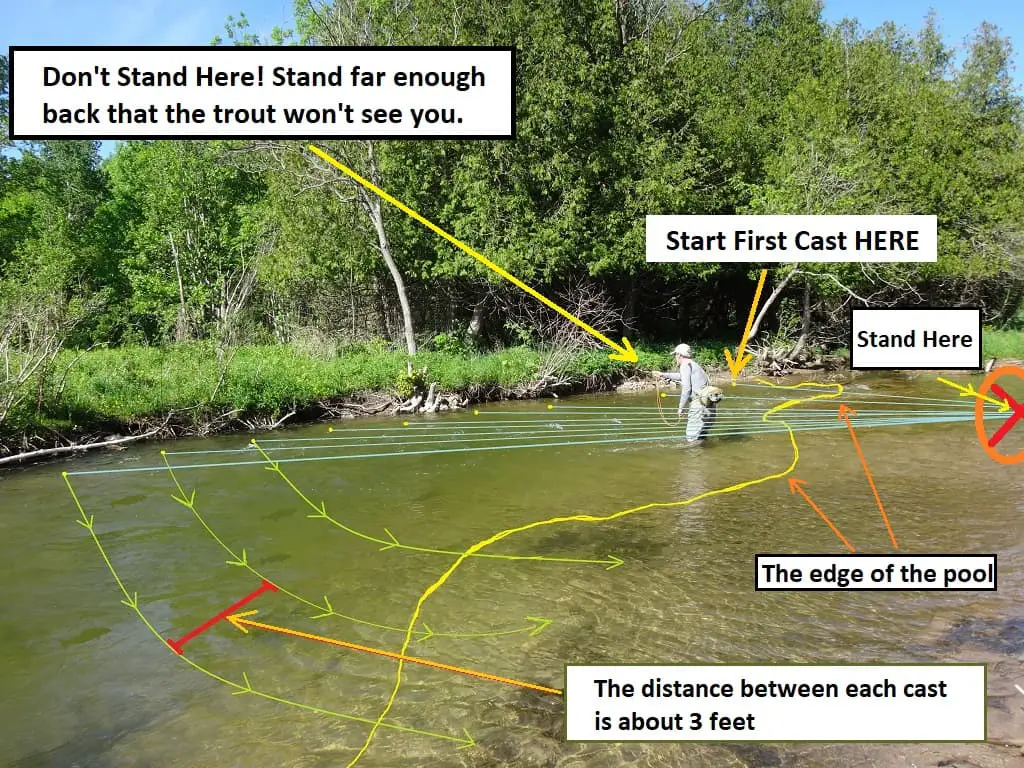
Cover The Depth Of The Water With Your Lures
You also need to cover the water at all depths, and this can be a bit tricky, but if you use these tips it can really help you catch more fish. In many rivers, we can’t see the bottom, so we don’t know how deep the spot is.
If we cast out a spinner or a spoon and start retrieving it, the lure may only go down 2 or 3 feet. That’s great if the spot is only 3 or 4 feet deep, but it’s bad if the spot is 7 to 9 feet deep.
Some trout won’t move more than a couple of feet, so it’s always best to get the lure within 24 inches of a trout.
Therefore, we have to find the bottom to make sure we are deep enough. The way I find the bottom is to use lures that run deeper, like a deep-diving crankbait or plug, or I will use sinking lures like a spinner or spoon
FYI, a wide-blade spinner will run shallower than a thin-blade spinner.
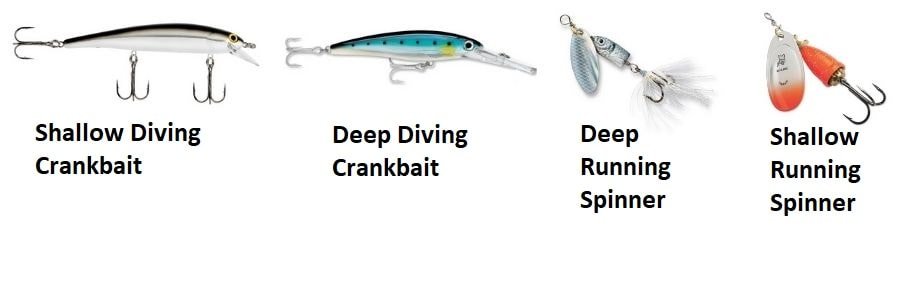
I cast and make a retrieve with my rod tip straight out or pointed slightly towards the water. If I don’t hit bottom, I will repeat the exact same cast, same spot, same path, but this time with my rod tip lower or even touching the water. If I don’t hit bottom, I repeat again, but this time it will be with my tip a foot or two into the water.
If I hit bottom on any cast I will lift my tip up, if it hit again partway through the cast I lift the tip even higher.
If I still do not hit bottom, I will change my lure to a deep diving lure or a weighted lure like a spoon or a spinner and repeat. If I still don’t hit bottom with these sinking lures, I will cast and let the lure sink for a few seconds before I start my retrieve.
If I hit bottom, I lift my tip, and on the next cast, I won’t wait as long before I start to retrieve. If I still don’t hit the bottom, I will wait longer to let the lure sink deeper before I start my retrieve.
I will repeat these steps from the top of the spot to the bottom of the spot. Once you figure out the lure or the sink time to find the bottom, all your other casts should be faster. The reason I keep trying to locate the bottom is that the top of the pool where the rapids come in might be 3 feet deep, but 10 feet downriver from that spot, it might be 7 or 8 feet deep.
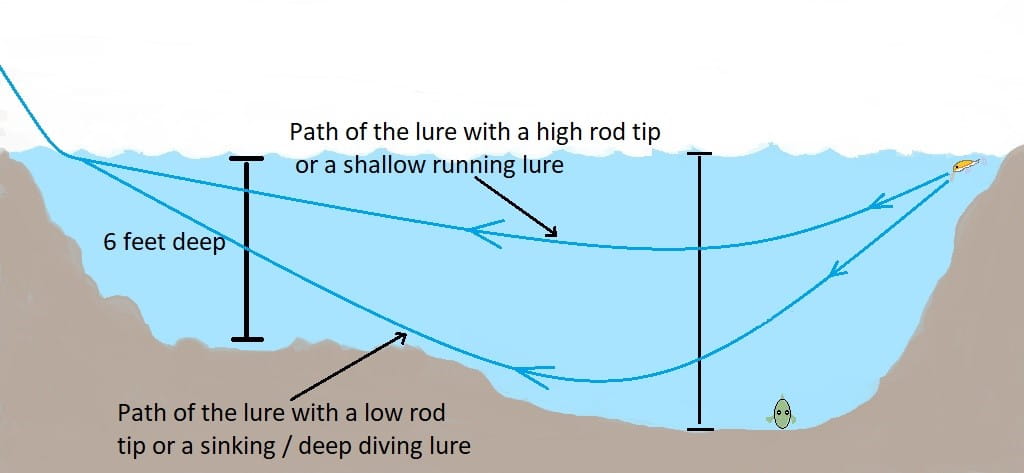
It’s also not uncommon for one side of the pool to be deeper than the other like in the picture, so pay attention to where in the retrieve you keep hitting the bottom.
Once you hit bottom, or if there is a high spot that you keep hitting, simply lift your tip high enough to raise the bait up and off the bottom at that point. You want to keep your bait about 12 to 24 inches off the bottom.
If you get good at covering the water systematically and you get good at finding the bottom and then lifting the lure up and off the bottom you can greatly increase the amount of fish you can catch.
Lures that drag the bottom get hung up often, and you will likely catch fewer fish, so don’t drag the bottom unless you want to lose a lot of lures.
Work Your Lure For More Trout
The last tip I will give you is to work your lure. The difference between a professional bass angler using a crankbait and a rookie angler using a crankbait is more than just the amount of fish they both catch. Yes, the bass guy will usually catch way more bass, even if they are both using the same lure simply because they work the lure better.
A lure that is cast out and then reeled straight in will catch fish, but a lure that is cast out and worked in will catch far more fish. Other guides, pro anglers, tournament anglers and I have proven this over and over again.
Often, the difference between a great angler and an average angler is how much effort they put into the lure.
I have taught many anglers how to do this well, and it always catches more trout. Trout and other predatory fish have a harder time resisting a dying, struggling, or injured fish.
If you reel your lure straight in, it looks healthy and fast and might get away, so it’s a harder target, but if you jerk it, rip it, and then pause it, then it looks injured and this is harder for even a neutral active fish to resist. The more erratic, the better sometimes.
Even with spinners and spoons, I will reel it in 5 to 10 feet and then rip or jig it with a split-second pause between rips and pauses to trigger a strike. Try it, it works!
Single Hook Laws And What To Do
In my area and on many trout rivers there are restrictions on the number of hooks that you are permitted to use by law.
In the case that you are only allowed to use a single hook, where do you put it? This is a question a reader asked, and since some of my best go-to trout rivers have single hook regulations I know all about this. This is my response about where to put your hook when you are only allowed to use one hook on a lure.
Do you put the hook in the front, middle, or back of the lure if you can only use one hook?
Where you put the hook on a lure when you are only allowed one hook depends on a few things, but if I had to choose one spot over another, I would say the back hook is usually the best spot to put a hook.
The reason that I say it depends is that the position of the hook might affect the action of the lure and a hook in the wrong spot might unbalance the lure enough that it just won’t run properly and therefore not work. If that is the case, I put the hook where the lure acts and runs properly when retrieved.
Experiment with different sized hooks in different spots and see how the lure works.
Where I put the hooks can also depend on the fish.
Some days I find that the fish will be very aggressive and they will smash the lure near the head, in which case I would want my hook in the middle or near the head of the lure, providing that the lure works with the hook in this spot.
On other days, the fish will be less aggressive or even curious and I have seen them nip at the back of the lure instead of grabbing the entire lure. When this happens, I will put the hook at the very back of the lure.
Somedays, I find that the fish will short-strike everything or keep missing the lure. They swipe at it and miss. When this happens, I want the hook at the back of the lure to increase my chances of hooking the fish.
If I find myself or my clients keep getting bumps on the lure but no fish stick, I will put the hook on the back, or I will only run lures in my box that already have the hook setup on the back. If we are getting bites and the fish are staying on, I keep using what’s working.
Tight Lines
Graham

Hello, Graham
On rivers that only permit single barbless, which position should you put the single hook, in the back or on the middle split ring ?
Thanks,
Hi Mike,
It depends on a few things, if I had to choose one over the other I would say the back hook is usually best.
The reason that I say it depends is that the position of the hook might affect the action of the lure. If that is the case put the hook where the lure acts and runs properly when retrieved.
It also depends on the fish. Some days I find them to be super aggressive and they smash the lure near the head, in which case I would want my hook in the middle or near the head. Other days the fish will be less aggressive or even curious and I have seen them nip at back the lure in which case you want the hooks at the back. Somedays they will short strike everything or keep missing the lure and in that case, I want the hook at the back.
If I find myself or my clients keep getting bumps but no fish, I will put the hook on the back or run lures with the hook already set up on the back. If we are getting bites and the fish are staying on, I keep using what’s working.
Hello, Graham
I like everything you write down, and can’t wait to see your YouTube videos. I have a question about fishing line, fluorocarbon, monofilament or copolymer for trout with lures only, with spinning rod and reel. Medium size river and trout sizes are from small, medium and very big.Georgia Chattahoochee river is full with big logs everywhere.
If you are asking about what size line for those conditions, I would think 8 pounds should be fine, I pull 10-pound steelhead out of water like that with only 8 pound line.
Good Luck
Graham
Thanks for this article. Do you bait your lure? If I’m using a spoon/spinner, is there any harm in throwing a worm or salmon egg on the tri-hook?
I do not add bait to the hook and have never found it to be more productive. I think the lure works better without any added bait. I have seen baits added to the hook that affected the performance or action of the lure so it’s better to leave the hook bare and let the lure work the way it is intended. The only exception is that I have in the past added a small plastic twister tail or grub tail for added action but even that is rare.
Good Luck
Graham